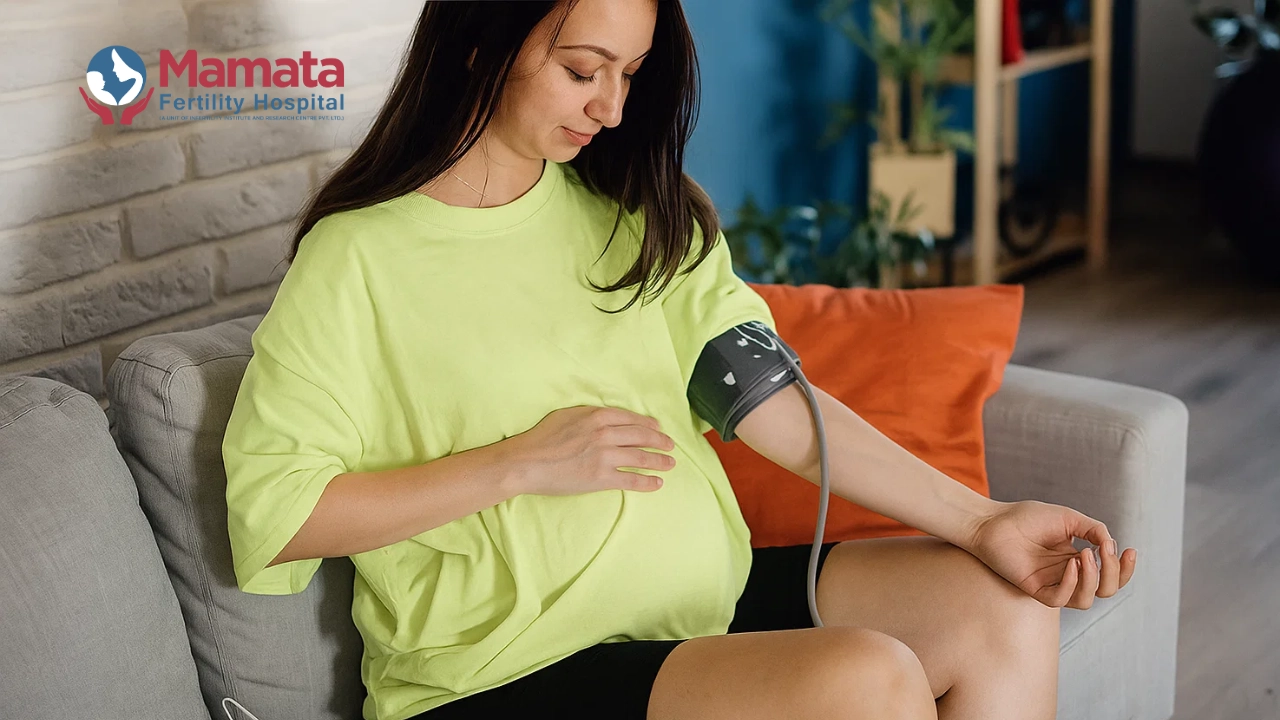How does preeclampsia affect the baby?

When a woman is diagnosed with preeclampsia during pregnancy, one of the first questions that often comes up is: how will this affect my baby? As someone who has cared for many expecting mothers at Mamata Fertility Hospital, I want to offer both information and reassurance.
While preeclampsia can pose risks to the baby, early diagnosis, careful monitoring, and modern medical care have made it possible for many babies to be born healthy despite this condition.
What Is Preeclampsia?
Preeclampsia is a pregnancy-related condition that typically develops after 20 weeks of pregnancy. It’s mainly identified by high blood pressure (140/90 mm Hg or higher) and may also include protein in the urine, swelling, headaches, and vision changes. In some cases, it can affect the liver, kidneys, and even lead to seizures, a condition known as eclampsia.
The exact cause of preeclampsia isn’t fully understood, but we do know that it often starts with how the placenta develops early in pregnancy. Poor development of the blood vessels that support the placenta can limit the oxygen and nutrients your baby receives, which is where many of the risks begin.
How Preeclampsia Affects the Baby
As I always explain to my patients, preeclampsia doesn’t directly harm the baby, but it affects the environment in which the baby grows. When the placenta isn’t functioning well, several challenges can arise for the baby:
Reduced Growth (Intrauterine Growth Restriction)
When the placenta isn’t able to deliver enough oxygen and nutrients, the baby may not grow at the expected rate. This is known as intrauterine growth restriction (IUGR). These babies are often smaller than average for their gestational age, which can lead to complications both before and after birth.
Fetal Distress
If oxygen levels drop too low, the baby may experience what we call fetal distress. This can lead to decreased movement, changes in heart rate, and, in some cases, emergency delivery to prevent harm.
Preterm Birth
One of the most significant effects of preeclampsia is the need for early delivery. In fact, preeclampsia is one of the most common reasons for medically indicated preterm birth. Babies born before 37 weeks may face challenges like breathing difficulties, temperature regulation problems, and feeding issues, often requiring care in the Neonatal Intensive Care Unit (NICU).
Stillbirth and Neonatal Death
In severe cases, especially if preeclampsia develops very early and goes untreated, there is a risk of stillbirth or the baby passing away shortly after birth. Fortunately, with vigilant monitoring and timely medical care, these outcomes have become far less common.
Long-Term Effects on the Baby
In my years of practice, one area that many parents worry about is the long-term impact on their child’s health. Research has shown that babies exposed to preeclampsia may face certain long-term risks, but it’s important to remember that many children born under these circumstances grow up to be healthy and thrive.
Heart and Blood Pressure Issues
Studies suggest that children who were exposed to preeclampsia in the womb may have a slightly higher chance of developing high blood pressure and heart problems later in life. This is why regular pediatric checkups are so important for early detection and prevention.
Metabolic Concerns
Some children may experience rapid catch-up growth after birth, which can raise the risk of developing obesity, diabetes, or metabolic syndrome as they get older.
Developmental and Behavioral Conditions
There is ongoing research examining connections between preeclampsia and conditions like autism spectrum disorder, ADHD, and learning difficulties. While some studies have suggested a possible link, the evidence is not conclusive. Many children develop normally without any long-term cognitive or behavioral issues.
Emotional and Mental Health
There is some data indicating that individuals exposed to preeclampsia before birth may have a slightly increased risk of depression or emotional disorders later in life, but this varies widely and is not inevitable.
How Do We Monitor and Protect the Baby?
When managing pregnancy after preeclampsia or during an ongoing preeclamptic pregnancy, our top priority is close monitoring to catch any issues early. We use several tools to keep both mother and baby safe:
- Regular ultrasounds to track the baby’s growth.
- Doppler studies to assess blood flow through the placenta and umbilical cord.
- Non-stress tests and fetal monitoring to observe the baby’s heart rate and movements.
- Blood tests and urine checks to monitor the mother’s condition.
These frequent checkups allow us to intervene early if signs of fetal distress or growth restriction appear.
Treatment Options to Support the Baby
Managing preeclampsia often involves balancing the health of both mother and baby. Medications like labetalol, nifedipine, and methyldopa are used to control the mother’s blood pressure, which helps maintain better blood flow to the baby. In severe cases, magnesium sulfate may be given to reduce the mother’s risk of seizures and protect the baby’s brain.
If early delivery becomes necessary, we often administer corticosteroid injections to help the baby’s lungs mature before birth. This preparation greatly improves outcomes for babies born prematurely.
Can Preeclampsia Be Prevented?
While we can’t always prevent preeclampsia entirely, certain steps can lower the risk. When working with patients who have a history of preeclampsia, I often recommend starting low-dose aspirin around 12 weeks of pregnancy. This simple treatment has been shown to reduce both the risk of preeclampsia recurrence and preterm birth.
Regular prenatal care is crucial. Early and frequent checkups allow us to identify and manage any developing issues before they become serious.
A Real-Life Perspective
I remember one patient who came to me after having preeclampsia in her first pregnancy. She was naturally nervous about trying again. With careful planning, early aspirin therapy, and close monitoring throughout her pregnancy, she was able to deliver a healthy baby at 38 weeks. Experiences like hers remind me that, while preeclampsia poses challenges, successful outcomes are very much possible with the right care.
Final Thoughts
If you’ve been diagnosed with preeclampsia or are considering pregnancy after preeclampsia, it’s normal to feel anxious. But please know that with modern medical care and careful monitoring, many babies are born healthy despite these complications. Understanding the risk of preeclampsia recurrence allows your care team to create a personalised plan to give both you and your baby the best possible outcome.
At Mamata Fertility Hospital, Hyderabad, we are committed to walking this journey with you, providing expert guidance every step of the way. With knowledge, preparation, and compassionate care, there is every reason to remain hopeful.

Dr Aarti Deenadayal Tolani
MBBS, MS ( OBGYN), FICOG
Clinical Director, Scientific In- Charge & Fertility Consultant with 15+ years Of Experience
CONSULT FERTILITY SPECIALIST
Latest BLOGS

Is it safe to get pregnant after preeclampsia?
Planning pregnancy after preeclampsia? Learn risks, safety tips, and care strategies from Mamata Fertility Hospital Hyderabad.

Can AI Predict Pregnancy Risk?
Discover how AI predict pregnancy risks, improves maternal care, and shapes safer pregnancies. Learn more from Mamata Fertility Hospital Hyderabad.

Miscarriage Risk by Week and Age
Learn miscarriage risk by week and age, causes, signs, and prevention tips. Get expert care from Mamata Fertility Hospital Hyderabad.

Irregular Periods During Breastfeeding: Causes, Symptoms & When to Seek Help
Breastfeeding can cause irregular periods due to hormonal changes. Learn why this happens, when to expect your cycle to return, and when to seek medical advice.


